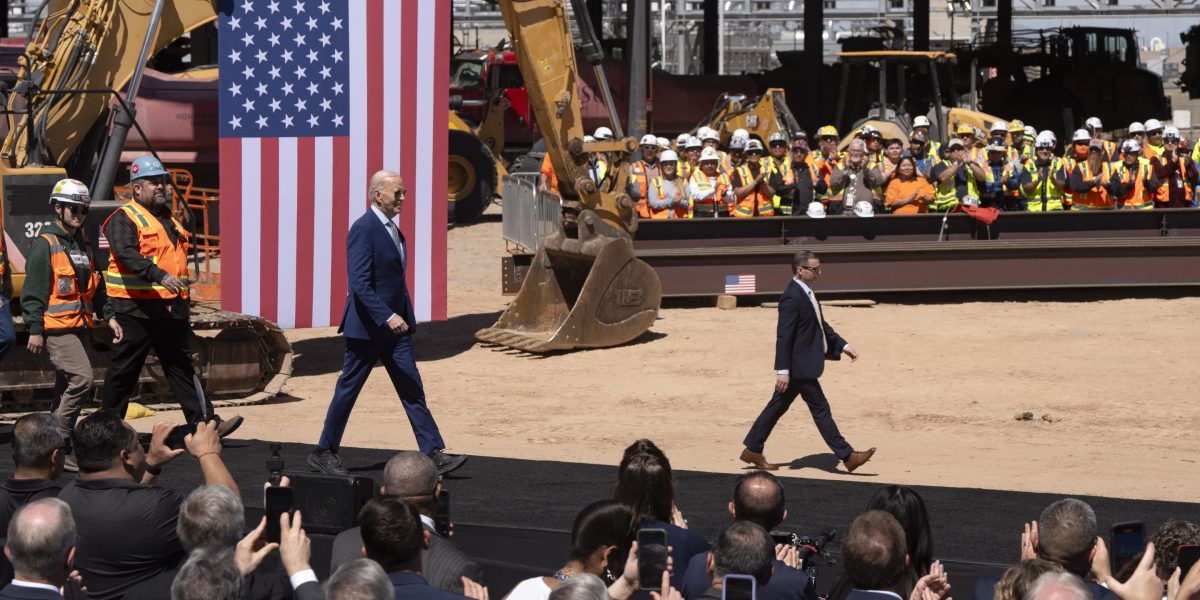This post was originally published on this site
https://fortune.com/img-assets/wp-content/uploads/2024/03/GettyImages-2092447315-e1711451087331.jpg?w=2048
In his State of the Union address, President Joe Biden touted how his administration’s actions are creating tens of thousands of new jobs and attracting billions of dollars of investments in sectors such as clean energy and advanced manufacturing. The remarks underscored what is shaping up to be a hallmark of Biden’s economic agenda: industrial policy.
It seems this once-shunned economic strategy is enjoying something of a renaissance. Throughout a career at the U.S. Department of Labor that spanned three very different administrations, I witnessed a shared aversion to industrial policy. On the rare occasions that leaders would broach the topic, the responses of my colleagues mostly ranged from unease to disdain. Democrats–and, to a certain extent, mainstream economists–bristled at the concept of directing policy toward discrete industries. The hesitation was, in part, fueled by distrust–what economist Dani Rodrik describes as a “knee-jerk hostility”–toward betting on businesses to make good on their commitment to the broader economy and its workers.
Republicans, meanwhile, may have been more trusting of the private sector, but they were often hesitant to intervene in the market through government investments. As Brian Deese, former director of the National Economic Council, puts it, “For much of the last half-century, even uttering the words ‘industrial policy’ was met with something between derision and concern.”
A dramatic policy shift
But times are changing. Under President Biden, the White House has not only secured huge investments in the semiconductor, manufacturing, and clean energy industries—as well as in construction, transportation, and broadband—but it has done so largely with bipartisan support. It’s clear that industrial policy is gaining acceptance across the political spectrum. Less clear is whether these investments will succeed where past attempts have struggled to make an impact. Federal, state, and workforce leaders will need to work together to ensure this dramatic policy shift lives up to its immense potential for transforming the lives of American workers for the better.
This begins with making sure workers who have traditionally been left out and left behind are able to benefit from—and thrive in—the jobs these investments stand to create.
Spurred by legislation like the CHIPS and Science Act, chip manufacturers are building plants across the country. In recent months, some of the largest manufacturers have announced delays, citing a lack of skilled workers. In fact, Deloitte estimates that the semiconductor industry will be short about 90,000 such workers over the next few years. The Biden administration’s recent $5 billion investment is, in part, a recognition of this challenge, with hundreds of millions of those dollars being directed toward the training of more semiconductor engineers. But with demand for skilled workers growing rapidly across a number of critical industries, it will require much more effort and funding to successfully ramp up the nation’s skills training infrastructure.
The workforce as a priority
While state workforce systems play a crucial role in connecting workers to opportunity, they are struggling to keep up with the ambition of Biden’s industrial policy approach. Regions are scrambling to navigate a mismatch between federal investments in job creation and investments in job training and other worker supports. They’re also navigating a mismatch between the types of training they historically provide and the needs of the employers at the receiving end of federal investments. Public workforce systems and local education providers, especially community and technical colleges, have long made it their mission to foster opportunities for workers who might otherwise be shut out. Meeting the demands of industrial policy’s resurgence will necessitate reimagining how these institutions collaborate to create intentional, sector-specific training opportunities for workers.
In Ohio, for example, companies like Intel, Honda, and Amgen are investing billions of dollars in chip manufacturing, electric vehicle production, and biomanufacturing facilities. In response, the state has tasked Columbus State Community College to lead an effort to build a pipeline of thousands of skilled workers. The college is forging deep partnerships with employers, labor organizations, K-12 and higher education partners, government leaders, non-profits, and other stakeholders.
Equally important are investments in wrap-around supports that ensure the workers who could benefit the most from accessing these new jobs are able to pursue the training necessary to do so. Such workers would likely have to balance education or training opportunities with their existing work and family obligations.
In fact, a provision within the CHIPS and Science Act acknowledges these barriers. Companies seeking federal grants of more than $150 million must provide both their facility and construction workers with access to affordable, high-quality child care. The need for child care and other wrap-around supports does not simply begin on a worker’s first day on the job, however. Workforce development initiatives should likewise be coupled with resources that empower workers to focus on the education they need to advance their careers.
Many of the jobs being created by industrial policy’s guiding hand are well-paying and provide workers with ample opportunities for career advancement. They are quality jobs that promote economic mobility and can serve as direct pathways into the middle class. This premise, however, hinges entirely on workers’ ability to develop the skills they need to access those jobs.
As this and future administrations debate whether to continue to double down on industrial policy, it is critically important to assess the true impact of such investments. Industrial policy’s surprise comeback must ultimately be measured not only by how successfully the strategy helps the United States compete on the global manufacturing stage but also by how it improves the lives of American workers and their communities.
Maria Flynn is president and CEO of national education and workforce nonprofit Jobs for the Future (JFF) and previously served as an executive in the U.S. Department of Labor during the Clinton and Bush administrations.
More must-read commentary published by Fortune:
The opinions expressed in Fortune.com commentary pieces are solely the views of their authors and do not necessarily reflect the opinions and beliefs of Fortune.



